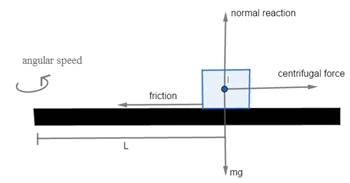A block of mass m is kept on a horizontal ruler. The friction coefficient between the ruler and the block is μ. The ruler is fixed at one end and the block is at a distance L from the fixed end. The ruler is rotated about the fixed end in the horizontal plane through the fixed end. (a) What can the maximum angular speed be for which the block does not slip? (b) If the angular speed of the ruler is uniformly increased from zero at an angular acceleration a, at what angular speed will the block slip?

When the system rotates the block will experience centrifugal force which will be balanced by friction. Normal reaction will be balance the force of gravitation.
So, ![]()
Now
![]()
![]()
![]()
(b) 
When there comes some amount of acceleration, friction starts working in the opposite direction of motion.
Here, radial acceleration will be due to centrifugal force.
![]()
The tangential acceleration will be,
![]()
![]()
![]()
![]()
It will start slipping as soon as the friction reaches its maximum value,
![]()
![]()

